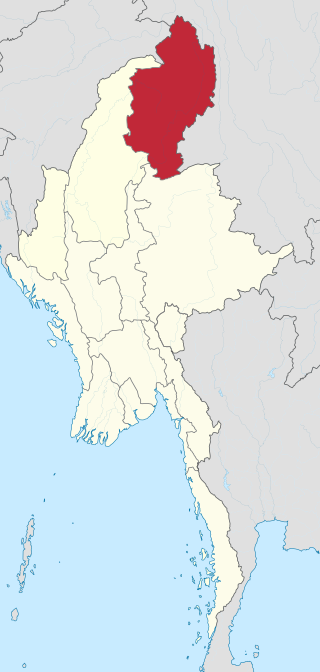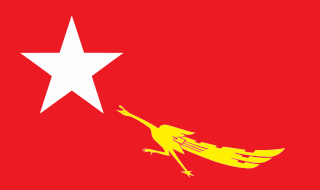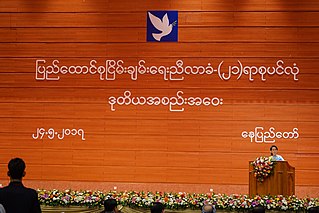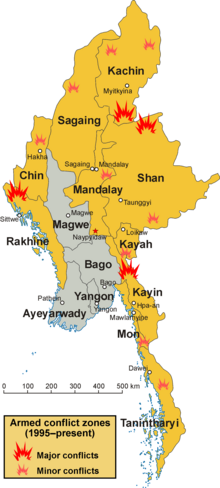
Aung San Suu Kyi, sometimes abbreviated to Suu Kyi, is a Burmese politician, diplomat, author, and a 1991 Nobel Peace Prize laureate who served as State Counsellor of Myanmar and Minister of Foreign Affairs from 2016 to 2021. She has served as the general secretary of the National League for Democracy (NLD) since the party's founding in 1988 and was registered as its chairperson while it was a legal party from 2011 to 2023. She played a vital role in Myanmar's transition from military junta to partial democracy in the 2010s.

Myanmar operates de jure as a unitary assembly-independent republic under its 2008 constitution. On 1 February 2021, Myanmar's military took over the government in a coup, causing ongoing anti-coup protests.

Kachin State is the northernmost state of Myanmar. It is bordered by China to the north and east ; Shan State to the south; and Sagaing Region and India to the west. It lies between north latitude 23° 27' and 28° 25' longitude 96° 0' and 98° 44'. The area of Kachin State is 89,041 km2 (34,379 sq mi). The capital of the state is Myitkyina. Other important towns include Bhamo, Mohnyin and Putao.

The Kachin peoples, more precisely the Kachin Wunpong or simply Wunpong, are a confederation of ethnic groups who inhabit the Kachin Hills in Northern Myanmar's Kachin State and neighbouring Yunnan Province, China, as well as Arunachal Pradesh, Assam in Northeastern India. About 1.5 million Kachin peoples live in the region. The term Kachin people is often used interchangeably with the main subset, called the Jingpo people in China.
The Panglong Conference, held in February 1947, was a historic meeting that took place at Panglong in the Shan States in Burma between the Shan, Kachin and Chin ethnic minority leaders and Aung San, head of the interim Burmese government. Aung Zan Wai, Pe Khin, Bo Hmu Aung, Sir Maung Gyi, Dr. Sein Mya Maung and Myoma U Than Kywe were among the negotiators of the historical Panglong Conference who negotiated with Bamar representative General Aung San and other ethnic leaders in 1947. All these leaders unanimously decided to join the Union of Burma. On the agenda was the united struggle for independence from Britain and the future of Burma after independence as a unified independent republic.
Insurgencies have been ongoing in Myanmar since 1948, the year the country, then known as Burma, gained independence from the United Kingdom. The conflict has largely been ethnic-based, with several ethnic armed groups fighting Myanmar's armed forces, the Tatmadaw, for self-determination. Despite numerous ceasefires and the creation of autonomous self-administered zones in 2008, many armed groups continue to call for independence, increased autonomy, or the federalisation of the country. The conflict is the world's longest ongoing civil war, having spanned more than seven decades.

Bo Hmu Aung was a Burmese military officer and a member of the legendary Thirty Comrades who trained in Japan in the struggle for independence from Britain and regarded as one of the founders of the Tatmadaw. He also served as Speaker of the Chamber of Deputies, was the lower house of the bicameral Union Parliament of independence Burma.

General elections were held in Myanmar on 7 November 2010, in accordance with the new constitution, which was approved in a referendum held in May 2008. The election date was announced by the State Peace and Development Council (SPDC) on 13 August.

The Shan State Army was one of the largest insurgent groups that fought government forces in Shan State, Myanmar (Burma). The SSA was founded in 1964 after the merging of two existing insurgent groups.

The 2011–2015 Myanmar political reforms were a series of political, economic and administrative reforms in Myanmar undertaken by the military-backed government. These reforms include the release of pro-democracy leader Aung San Suu Kyi from house arrest and subsequent dialogues with her, establishment of the National Human Rights Commission, general amnesties of more than 200 political prisoners, institution of new labour laws that allow labour unions and strikes, relaxation of press censorship, and regulations of currency practices. As a consequence of the reforms, ASEAN has approved Myanmar's bid for the chairmanship in 2014. United States Secretary of State Hillary Clinton visited Myanmar on 1 December 2011, to encourage further progress; it was the first visit by a Secretary of State in more than fifty years. United States President Barack Obama visited one year later, becoming the first US president to visit the country.
Ceasefires in Myanmar have been heavily utilized by the Burmese government as a policy to contain ethnic rebel groups and create tentative truces. The first ceasefire was arranged by the State Law and Order Restoration Council in 1989, specifically spearheaded by Khin Nyunt, then the Chief of Military Intelligence, with the Kokang-led National Democratic Alliance Army, which had recently split from the Communist Party of Burma due to internal conflicts.

The Kachin conflict or the Kachin War is one of the multiple conflicts which are collectively referred to as the internal conflict in Myanmar. Kachin insurgents have been fighting against the Tatmadaw since 1961, with only one major ceasefire being brokered between them, which lasted from 1994 to 2011, a total of 17 years.

General elections were held in Myanmar on 8 November 2015, with the National League for Democracy winning a supermajority of seats in the combined national parliament. Voting occurred in all constituencies, excluding seats appointed by the military, to select Members of Assembly to seats in both the upper house and the lower house of the Assembly of the Union, and State and Region Hluttaws. Ethnic Affairs Ministers were also elected by their designated electorates on the same day, although only select ethnic minorities in particular states and regions were entitled to vote for them.

The Union Peace Conference – 21st Century Panglong was a peace conference, the first session of which was held from 31 August to 4 September 2016 at the Myanmar Convention Centre 2 in Naypyidaw, Myanmar (Burma). Three follow-up sessions were held in May 2017, July 2018, and August 2020.

The Shanni Nationalities Army is a Shanni insurgent group active in northern Sagaing Region and Kachin State, Myanmar (Burma). It was founded as a group in 1989 but was transformed into an armed group in January 2016 by expelled Shanni members of the Kachin Independence Army. The SNA has five objectives – to gain statehood, to fight drugs, to establish a federal Union, to build unity among all Shan sub-groups, and to conserve ecological balance.
The Muse offensive, also known as the Mong Ko offensive, was a joint military operation by members of the Northern Alliance, which consists of the Arakan Army (AA), the Kachin Independence Army (KIA), the Myanmar National Democratic Alliance Army (MNDAA) and the Ta'ang National Liberation Army (TNLA). The groups targeted towns and border posts along the China–Myanmar border in Muse Township, Myanmar.

Pe Thein Zar was a Mon student leader, lawyer, revolutionary, and writer who was imprisoned for seven years for his activism. He earned a BA (History) degree from Rangoon University.

General elections were held in Myanmar on 8 November 2020. Voting occurred in all constituencies, excluding seats appointed by or reserved for the military, to elect members to both the upper house - Amyotha Hluttaw and the lower house - Pyithu Hluttaw of the Assembly of the Union, as well as State and Regional Hluttaws (legislatures). Ethnic Affairs Ministers were also elected by their designated electorates on the same day, although only select ethnic minorities in particular states and regions were entitled to vote for them. A total of 1,171 national, state, and regional seats were contested in the election, with polling having taken place in all townships, including areas considered conflict zones and self-administered regions.

Sumlut Gun Maw is an officer of the Kachin Independence Army who is currently serving as the vice chief-of-staff with the rank of brigadier general since 2009.
Esther Ze Naw is a Burmese humanitarian and ethnic minority rights activist. She appeared on the Time 100 for 2021, along with Ei Thinzar Maung.













